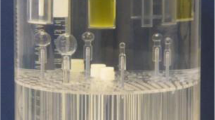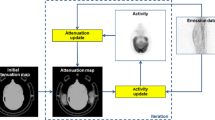Abstract
Objectives
Clinical PET/MR requires the use of patient positioning aids to immobilize and support patients for the duration of the combined examination. Ancillary immobilization devices contribute to overall attenuation of the PET signal, but are not detected with conventional MR sequences and, hence, are ignored in standard MR-based attenuation correction (MR-AC). We report on the quantitative effect of not accounting for the attenuation of patient positioning aids in combined PET/MR imaging.
Methods
We used phantom and patient data acquired with positioning aids on a PET/CT scanner (Biograph 16, HI-REZ) to mimic PET/MR imaging conditions. Reference CT-based attenuation maps were generated from measured (original) CT transmission images (origCT-AC). We also created MR-like attenuation maps by following the same conversion procedure of the attenuation values except for the prior delineation and subtraction of the positioning aids from the CT images (modCT-AC). First, a uniform 68Ge cylinder was positioned centrally in the PET/CT scanner and fixed with a vacuum mattress (10 cm thick) and, in a repeat examination, with MR positioning foam pads. Second, 16 patient datasets were selected for subsequent processing. All patients were regionally immobilized with positioning aids: a vacuum mattress for head/neck imaging (nine patients) and a foam mattress for imaging of the lower extremities (seven patients). PET images were reconstructed following CT-based attenuation and scatter correction using the original and modified (MR-like) CT images: PETorigCT-AC and PETmodCT-AC, respectively. PET images following origCT-AC and modCT-AC were compared visually and in terms of mean differences of voxels with a standardized uptake value of at least 1.0. In addition, we report maximum activity concentration in lesions for selected patients.
Results
In the phantom study employing the vacuum mattress the average voxel activity in PETmodCT-AC was underestimated by 6.4% compared to PETorigCT-AC, with 3.4% of the PET voxels being underestimated by 10% or more. When the MR foam pads were not accounted for during AC, PETmodCT-AC was underestimated by 1.1% on average, with none of the PET voxels being underestimated by 10% or more. Evaluation of the head/neck patient data showed a decrease of 8.4% ([68Ga]DOTATOC) and 7.4% ([18F]FDG) when patient positioning aids were not accounted for during AC, while the corresponding decrease was insignificant for the lower extremities.
Conclusion
Depending on the size and density of the positioning aids used, a regionally variable underestimation of PET activity following AC is observed when positioning aids are not accounted for. This underestimation may become relevant in combined PET/MR imaging of patients with neuropsychiatric indications, but appears to be of no clinical relevance in imaging the extremities.






Similar content being viewed by others
References
Pichler BJ, Kolb A, Nägele T, Schlemmer H-P. PET/MRI: Paving the way for the next generation of clinical multimodality imaging applications. J Nucl Med. 2010;51(3):333–6. doi:10.2967/jnumed.109.061853.
Schlemmer HP, Pichler BJ, Schmand M, Burbar Z, Michel C, Ladebeck R, et al. Simultaneous MR/PET imaging of the human brain: feasibility study. Radiology. 2008;248(3):1028–35. doi:10.1148/radiol.2483071927.
Ratib O, Becker M, Vallee JP, Loubeyre P, Wissmeyer M, Willi J-P, et al. Whole body PET-MRI scanner: first experience in oncology. J Nucl Med. 2010;51 Suppl 2:165.
Hofmann M, Pichler B, Scholkopf B, Beyer T. Towards quantitative PET/MRI: a review of MR-based attenuation correction techniques. Eur J Nucl Med Mol Imaging. 2009;36 Suppl 1:S93–104. doi:10.1007/s00259-008-1007-7.
Keereman V, Fierens Y, Broux T, De Deene Y, Lonneux M, Vandenberghe S. MRI-based attenuation correction for PET/MRI using ultrashort echo time sequences. J Nucl Med. 2010;51(5):812–8. doi:10.2967/jnumed.109.065425.
Beyer T, Tellmann L, Nickel I, Pietrzyk U. On the use of positioning aids to reduce misregistration in the head and neck in whole-body PET/CT studies. J Nucl Med. 2005;46(4):596–602.
Brechtel K, Heners H, Mueller M, Aschoff P, Eschmann SM, Bares R, et al. Fixation devices for whole-body 18F-FDG PET/CT: patient perspectives and technical aspects. Nucl Med Commun. 2007;28(2):141–7. doi:10.1097/MNM.0b013e328013eb09.
Boss A, Bisdas S, Kolb A, Hofmann M, Ernemann U, Claussen CD, et al. Hybrid PET/MRI of intracranial masses: initial experiences and comparison to PET/CT. J Nucl Med. 2010;51(8):1198–205. doi:10.2967/jnumed.110.074773.
Martinez-Möller A, Souvatzoglou M, Delso G, Bundschuh RA, Chefd'hotel C, Ziegler SI, et al. Tissue classification as a potential approach for attenuation correction in whole-body PET/MRI: evaluation with PET/CT data. J Nucl Med. 2009;50(4):520–6. doi:10.2967/jnumed.108.054726.
Delso G, Martinez-Möller A, Bundschuh RA, Ladebeck R, Candidus Y, Faul D, et al. Evaluation of the attenuation properties of MR equipment for its use in a whole-body PET/MR scanner. Phys Med Biol. 2010;55(15):4361–74. doi:10.1088/0031-9155/55/15/011.
Mantlik F, Hofmann M, Kupferschläger J, Werner M, Pichler B, Beyer T. The effect of positioning aids on PET quantification following MR-based attenuation correction (AC) in PET/MR imaging. J Nucl Med. 2010;51 Suppl 2:1418.
Antoch G, Bockisch A. Combined PET/MRI: a new dimension in whole-body oncology imaging? Eur J Nucl Med Mol Imaging. 2009;36 Suppl 1:S113–20. doi:10.1007/s00259-008-0951-6.
Son Y-D, Kim H-K, Kim S-T, Kim N-B, Kim Y-B, Cho Z-H. Analysis of biased PET images caused by inaccurate attenuation coefficients. J Nucl Med. 2010;51(5):753–60. doi:10.2967/jnumed.109.070326.
Catana C, van der Kouwe A, Benner T, Michel CJ, Hamm M, Fenchel M, et al. Toward implementing an MRI-based PET attenuation-correction method for neurologic studies on the MR-PET brain prototype. J Nucl Med. 2010;51(9):1431–8. doi:10.2967/jnumed.109.069112.
Nawaz A, Torigian DA, Siegelman ES, Basu S, Chryssikos T, Alavi A. Diagnostic performance of FDG-PET, MRI, and plain film radiography (PFR) for the diagnosis of osteomyelitis in the diabetic foot. Mol Imaging Biol. 2010;12(3):335–42. doi:10.1007/s11307-009-0268-2.
Sauter A, Horger M, Boss A, Kolb A, Mantlik F, Kanz L, et al. Simultaneous PET/MRI for the evaluation of hemato-oncological diseases with lower extremity manifestations. J Nucl Med. 2010;51 Suppl 2:1001.
Ladebeck R. Method for determining attenuation values of an object. US Patent Appl. No. 12/458368, Pub. No. US 2010/0007346 A1. Published Jan 14, 2010.
Acknowledgments
We thank Mrs Henriette Heners for helping with the data processing and Drs. Andreas Boss, Matthias Reimold and Nina Schwenzer for helpful discussions. This study was supported in part by a grant from the German Research Foundation (DFG) PI 771/5-1.
Conflicts of Interest
T.B. is founder and president of cmi-experts GmbH and reports no conflict of interest.
Author information
Authors and Affiliations
Corresponding author
Rights and permissions
About this article
Cite this article
Mantlik, F., Hofmann, M., Werner, M.K. et al. The effect of patient positioning aids on PET quantification in PET/MR imaging. Eur J Nucl Med Mol Imaging 38, 920–929 (2011). https://doi.org/10.1007/s00259-010-1721-9
Received:
Accepted:
Published:
Issue Date:
DOI: https://doi.org/10.1007/s00259-010-1721-9




